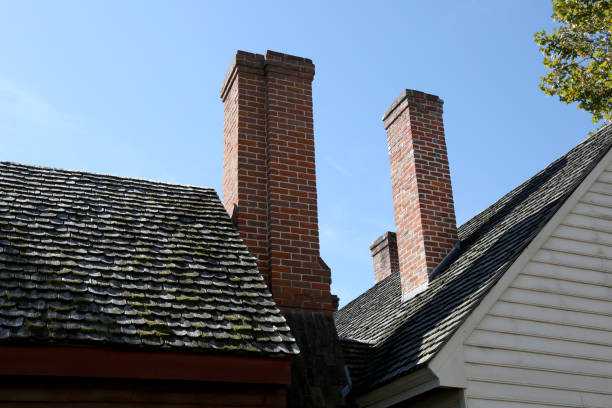A well-maintained chimney is essential for the safety and efficiency of your home. Many homeowners overlook the importance of regular chimney cleaning, which can lead to hazardous conditions such as chimney fires, carbon monoxide buildup, and reduced heating efficiency. This article explores why regular chimney maintenance is crucial and how it can keep your home safe and warm.
Understanding the Dangers of a Dirty Chimney
A chimney’s primary function is to safely vent smoke, gases, and other byproducts of combustion out of your home. However, over time, soot, ash, and creosote accumulate inside the chimney, creating several potential risks:
1. Fire Hazard
One of the most significant dangers of a neglected chimney is the risk of chimney fires. Creosote, a highly flammable substance, builds up inside the chimney walls when wood burns. If not cleaned regularly, a thick layer of creosote can ignite, causing a chimney fire that may spread to the rest of your home. According to the National Fire Protection Association (NFPA), chimney fires are one of the leading causes of house fires in the United States.

2. Carbon Monoxide Poisoning
A blocked or dirty chimney can lead to improper ventilation, allowing carbon monoxide (CO) to enter your living space. CO is an odorless, colorless gas that can be deadly when inhaled in large amounts. Symptoms of CO poisoning include headaches, dizziness, nausea, and confusion. Regular chimney cleaning helps prevent blockages, ensuring that toxic gases are safely vented outside.
3. Reduced Heating Efficiency
A clogged chimney restricts airflow, causing your fireplace or wood stove to burn inefficiently. This means you’ll need to use more fuel to achieve the same level of warmth, leading to increased energy costs. A clean chimney allows for proper combustion and better heat distribution throughout your home.
Signs That Your Chimney Needs Cleaning
While regular inspections by a professional are recommended, there are several signs that indicate your chimney needs immediate attention:
- Excessive Creosote Buildup: If you notice thick black soot or tar-like substance inside your chimney, it's time for a cleaning.
- Poor Drafting: If smoke is entering your home instead of being drawn up through the chimney, there could be a blockage.
- Foul Odors: A musty or burnt smell coming from the fireplace may indicate creosote buildup.
- Slow Burning Fires: If your fires struggle to stay lit or burn weakly, airflow restrictions could be the culprit.
- Presence of Animals or Debris: Birds, squirrels, and other small animals sometimes nest in chimneys, causing dangerous obstructions.
How Often Should You Clean Your Chimney?
The frequency of chimney cleaning depends on several factors, including how often you use your fireplace and the type of fuel you burn. The NFPA recommends an annual inspection and cleaning at least once a year. However, if you use your fireplace frequently, especially during winter months, more frequent cleanings may be necessary.
DIY vs. Professional Chimney Cleaning
Some homeowners attempt to clean their chimneys themselves, but hiring a professional chimney sweep is the safest and most effective option. Here’s why:
DIY Cleaning
- Can be messy and time-consuming.
- Requires special tools such as chimney brushes, rods, and vacuums.
- May not remove all creosote buildup, leaving potential fire hazards.
Professional Cleaning
- Chimney sweeps have specialized tools and training to thoroughly clean your chimney.
- Professionals can identify and address underlying structural issues.
- Saves you time and ensures safety compliance with local regulations.
The Chimney Cleaning Process
A professional chimney sweep follows a thorough process to ensure your chimney is clean and safe:
- Inspection: The technician examines the chimney for blockages, cracks, and other structural issues.
- Preparation: Floors and furniture near the fireplace are covered to prevent soot from spreading.
- Sweeping: Special brushes and vacuums are used to remove creosote and debris.
- Final Check: The technician ensures proper ventilation and confirms the chimney is safe for use.
Additional Chimney Maintenance Tips
In addition to regular cleanings, follow these maintenance tips to keep your chimney in optimal condition:
- Use Seasoned Wood: Dry, well-seasoned wood produces less creosote than green or damp wood.
- Install a Chimney Cap: A chimney cap prevents debris, animals, and rain from entering the chimney.
- Check for Damage: Regularly inspect your chimney’s exterior for cracks, loose bricks, or deteriorating mortar.
- Schedule Annual Inspections: Professional inspections help detect potential problems before they become major issues.
Regular chimney cleaning is essential for preventing fire hazards, improving heating efficiency, and protecting your family from carbon monoxide poisoning. By investing in routine maintenance and professional inspections, you can ensure a safe and cozy home environment. Don’t wait until a problem arises—schedule a chimney cleaning today and enjoy peace of mind all year round.







